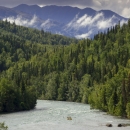This project utilizes Forward Looking InfraRed (FLIR) data to detect temperature variation and impacts on spawning distribution of Chinook and Coho Salmon returning to the Kenai Peninsula's Funny River and Moose River in Alaska. Thermal imagery has been used to make assumptions about critical fish habitat and suboptimal temperatures often based on a single flight. This study seeks to further refine the utility of FLIR data and its applicability to making inferences about fish distribution and critical habitats with multiple flights conducted throughout the open-water season. The project also seeks to determine the relationship between mid-water temperature loggers, water surface temperature loggers, and FLIR imagery that may provide a basis for future FLIR studies with less intensive groundwork.
Monitoring, Research



